Dear Friends and Partners,
It was an uneasy sleep that night. Despite the tumult just beyond cook tent, I tried to sleep on the ground in cow camp on the banks of the river, eyeing the sprinkling of stars through the latticework of bud-bursting cottonwood trees. Linnaea lay passed out beside me, in peace for God only knows what reason.
I think it’s because she didn’t take a look at the river bank, only 30 feet behind our cook kitchen tarp. I just had to. And it was that one look by headlamp light that cost me a restful night.
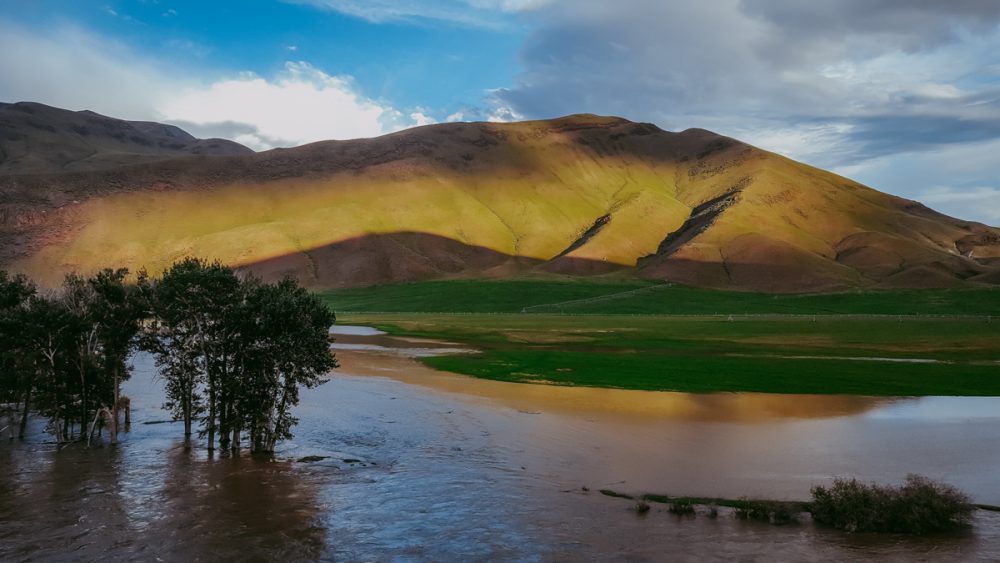
The water was only 10 inches from cresting the bank. Yesterday it was 2 feet from the bank. If it rose beyond the bank, I believed that the water, if not the river would envelop us. The torrent was simply ripping. In the dusk several hours before, we noted entire trees, their roots jaunted skyward, tumbling down the Salmon River. We could both hear the sound of boulders on the bottom rattling downriver like the muffled sound of crashing pins at a bowling alley.
It was a perfect formula for flood stage: record snowfalls in the winter of 16/17 with an unseasonably warm string of days at the end of May. Up until that warm spell, the high peaks of the upper Salmon River basin were cloaked with a permanent looking icecap of winter white. Now it was melting.
I got up in the dark with headlamp to look at the river in the wee hours, likely around 4 AM. Slipping on my cowboy boots, I felt the sandy soil give underfoot that was the substrate of the thick cottonwood forest we camped in. The forest soil was a sponge, and the high river next to the bottomland timber was soaking into it.
Relief. The river had dropped. The cool of the night had slowed the rapid melt in the mountain snowfields. We would be OK until tomorrow, at least. I sighed a breath of relief, as I walked over to our night pen, where horses and cattle rested. There were 250 head here, and in the moonless night, it would have been a serious chore to get them to find their way out of the trees to higher ground. Pictures of bawling yearling steers being swept downriver had occupied my mind for most of the night. After all, just a quarter mile downstream was the terrific whitewater of Cronk’s Canyon.
I wondered how they could possibly make it through.
The next day dawned fair enough, but clouds rushed in to cover the sun. It stayed cool, and looked like rain. The river dropped further, despite the daytime. It was because in the mountains, it had barely risen above freezing. The meltwater would hold, at least for today. We could keep our camp.
The river camp was the only way to graze the low country along the river. Because of the winter moisture, it was an amazing grass year. The river breaks were like hayfields with native forage. Everything growing in abandoned exuberance this spring because of the high soil moisture in the semi-high desert environment.
Even the morels.
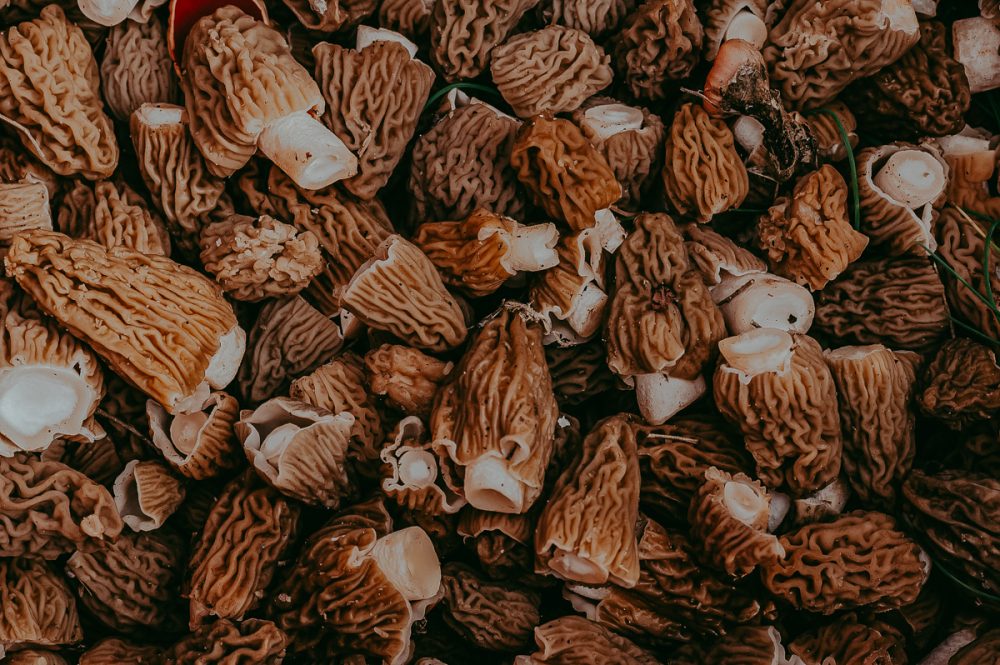
It was another reason to camp in the bottoms: fringe benefits. Our previous crew, Buck and Sue, had picked two sacks of morels for their nighttime fare in camp just this previous week. They almost foundered on them, fried over the campfire in a cast iron skillet bathed in a heathy dose of butter. They happily left Linnaea and I some. We eagerly waited all day, grazing the cattle on the canyon breaks, hoping we got them back in with enough daylight to find more. We gathered more fruit off the land on the hills: bitterroot, which the native Shoshoni considered a staple.
Digging the roots up was easy with a pocketknife. Then, rolling them between your hands, you’ll expose the naked white inner flesh, and the tough, dirty and leathery outside peels easily away. A sampling bite told us what the Shoshoni had already known: you must cook them to eat them. Man, were they bitter.
Alas, our cooling trend stole our chances at morels. Linnaea and I only found a handful. We didn’t have much more to eat besides a few sirloin steaks I brought from the ranch, but it was enough. We tried the bitterroot in many ways; boiled with butter, fried in olive, pounded into cakes. All were tolerable, but there was always, ever a shot of bitterness with it.
A friend of mine’s wife is Laotian. After serving him some, he ate it readily. He said “Actually, it is like a lot of what my wife cooks. Laotian food has many bitter qualities to it. I could totally live on this root.”
I didn’t think I could. But the morels, as always, were to die for. Bathed in butter, with a little garlic or onion, they found the spot. Ever since then, we’ve been dedicated seekers of the elusive fungus.
Morels live worldwide, in symbiosis with trees. Trees need them; they need trees. Tree roots extract nutrients and waters from the morel fungal mycelium—the underground threads that network healthy soils. In exchange, the mycelial web gathers sugars coming down from the leaves as the tree gathers sunlight. And the fungal network is fed.
And, when conditions are right, the mycelial web produces fruiting bodies, or the mushroom itself. These then are spreaders of millions of spores into the air, which then find new places to grow mycelium in host species that are often very specific to individual species of mushroom.
And that is almost the entirety of information known about morels. At the turn of the century, there were some 80 morel species described. Now, using DNA sequencing, that list has in most circles shrunk. However, there are still some mycologists that believe that there are possibly hundreds of just morel mushrooms species worldwide.
The underground (literal and figurative) world and working of mushrooms is a mystery. It’s a vast uncharted territory for even mycologists. Much of our current knowledge (belief?) comes from applying principles from plant physiology and taxonomy to fungi.
And the fungi keep breaking those rules, since they never did follow the plant book. It’s why fungi are there in their own kingdom, clearly delineated from plants and animals. And things get even more complex when catastrophic disturbances threaten fungal habitats.
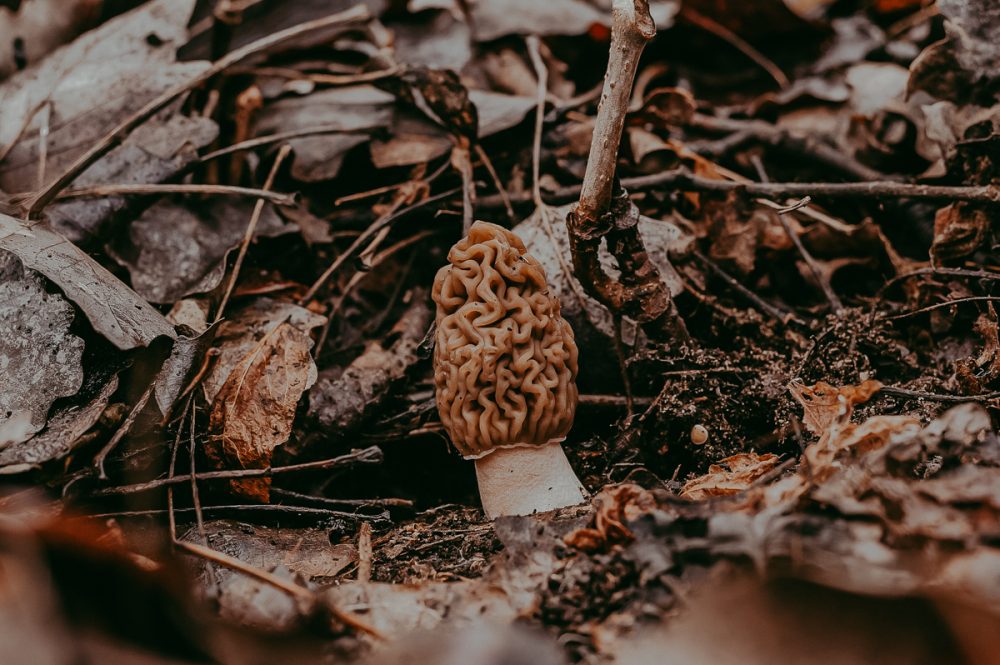
Last summer, the heat and low rainfall of June and July set the stage for wildfire. The Rabbit Foot fire gobbled up 32,000 acres of Douglas-fir and lodgpole pine forest in the Salmon River mountains, 8,000 acres of which was our Hat Creek grazing range.
It was time to collect some payback for our lost grass the summer before, and the Alderspring Crew was ready. We had heard word that the springtime morel flush was sweeping the burn areas of the Rabbit Foot, and on one Sunday afternoon, we set out in four wheel drives to find the fire pioneer.
Burn morels are common in the coniferous forests of the western US, as is wildfire. Weather patterns and rain shadow effects cause wholesale drying of forest environments in the west, and the regular dry lightning storms that typify much of the mountain regions provide a handy ignition source.
Originally to the surprise of morel enthusiasts and scientists alike, burn morels are now commonly believed to be different species than those that commonly show up in the spring in unburned forests. They simply do not fruit until the disturbance of fire sets in motion a response of the underground mycelial network to put fruit–mushrooms–up through the forest floor, in an often quite abundant display.
No-one knows why, at this time, the mushrooms appear. After all, the trees, their probable host species are largely dead. No energy to gather from them. But to release spores, it’s apparent they need fire.
When we arrived in the late spring, the snow had just left the blackened forests of the Rabbit Foot fire. The ground was moist. And, at first, it seemed as if we were to strike out. Only a few dome-like tops of the mushrooms were pushing their way up through the ashy duff.
“Five bucks to the person who finds the first morel over 2 inches long!” I yelled over the blackened mountainside.

Foraging for mushrooms in a burn area… 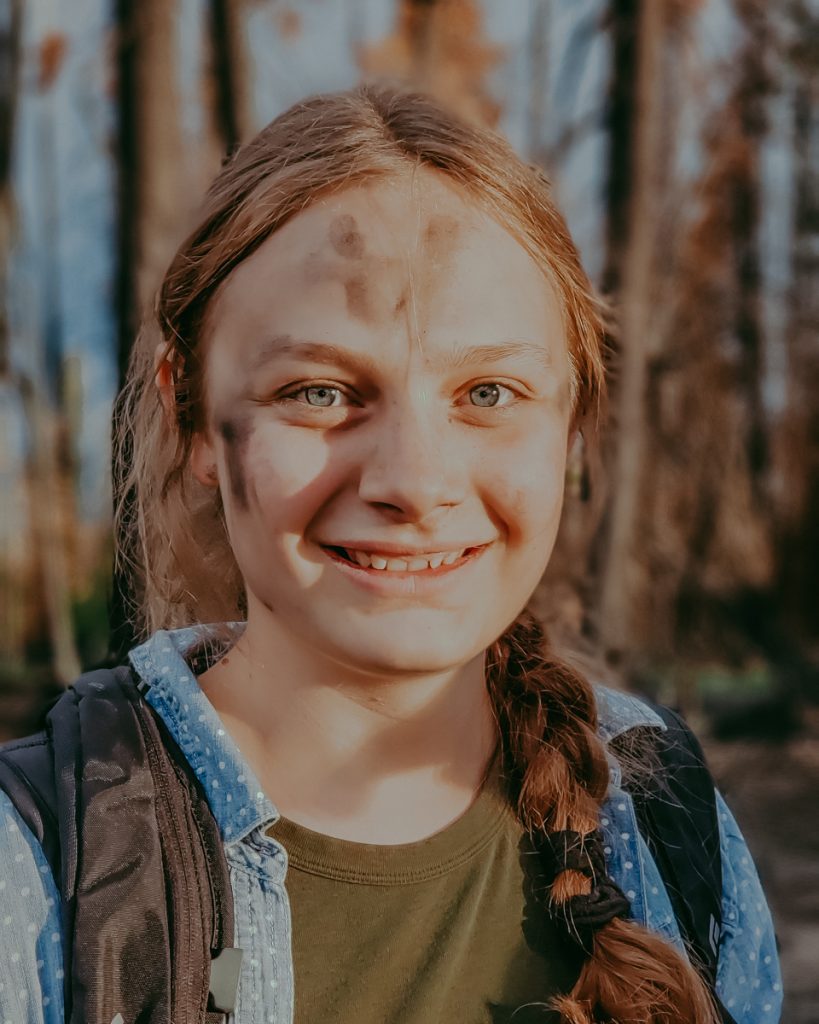
…means getting a little bit grimy and soot covered. The bounty was well worth it!
After a few more minutes, finally, from the other side of the ravine, a daughter called out: “I have one!”
And then, we began to learn the habit of the fungus. First, we noted that they grew in clusters. Where one morel was found, there would be more. Second, we discovered that they liked the exceptionally moist areas, along creeks and moist depressions. Third, we found them where the burn was complete—the ashy gray substrate under a completely ravaged forest.
And in several hours, we had grocery bags full. The fire had begun paying us back.
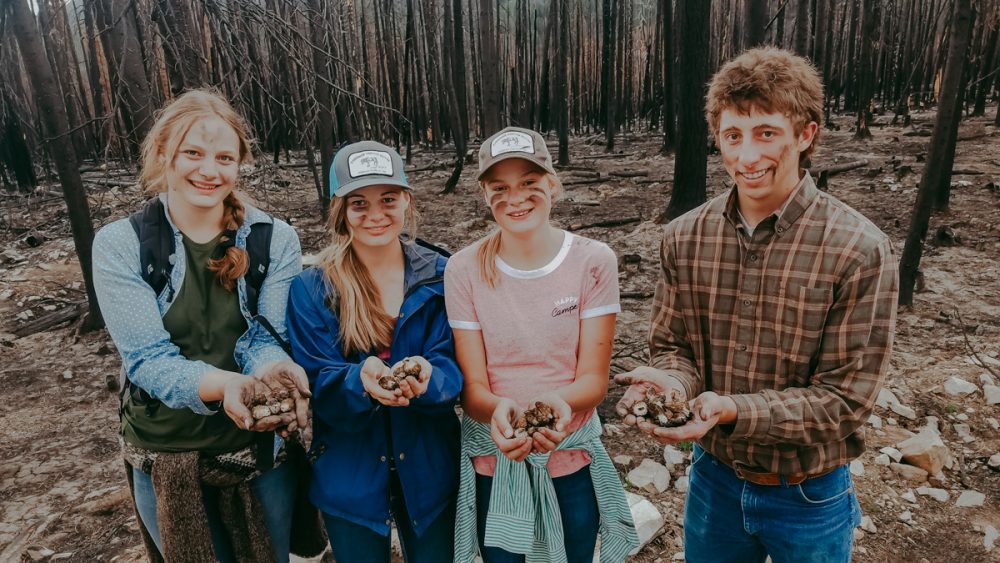
Now, you may think the morel is just another button mushroom. But a fresh morel is quite sensational in comparison. Paired with a lovely steak and a light salad, well, taste and flavor memories become melodic and even symphonic in comparison to their non-wild and very distant cousins from the grocery store.
And that is how nature often works with us. It seems even though we are forced through fire, storm and high water, there’s always this little (or sometimes really quite big) gift at the end of it. A blessing despite the trial.
And I think sometimes we forget to look for it. It’s there in the shade of the cottonwoods, when high water hits the bottoms. We’ll step on those morels all day long, or let the beeves get them.
Until we take the time to stop and look down to find them there.
Or we see where the fire burned lightly through upper Big Hat. The sagebrush is removed—charred skeletons of where once a closed canopy stood. And through it all, threaded through the blackened lattice work of burnt twigs, rises Great Basin wild ryegrass. All but extirpated, it has been patiently waiting as seed for such a time as this. Covering the ground in luxuriant tallgrass green.
And we never knew it was there. We’ll graze it someday; but first, we need to allow it 3 or 4 years to get a firm hold. And we’ll only graze it one year out of every five or so—to allow it to maintain, and enhance that diverse landscape mosaic of timber, sage and grassland.
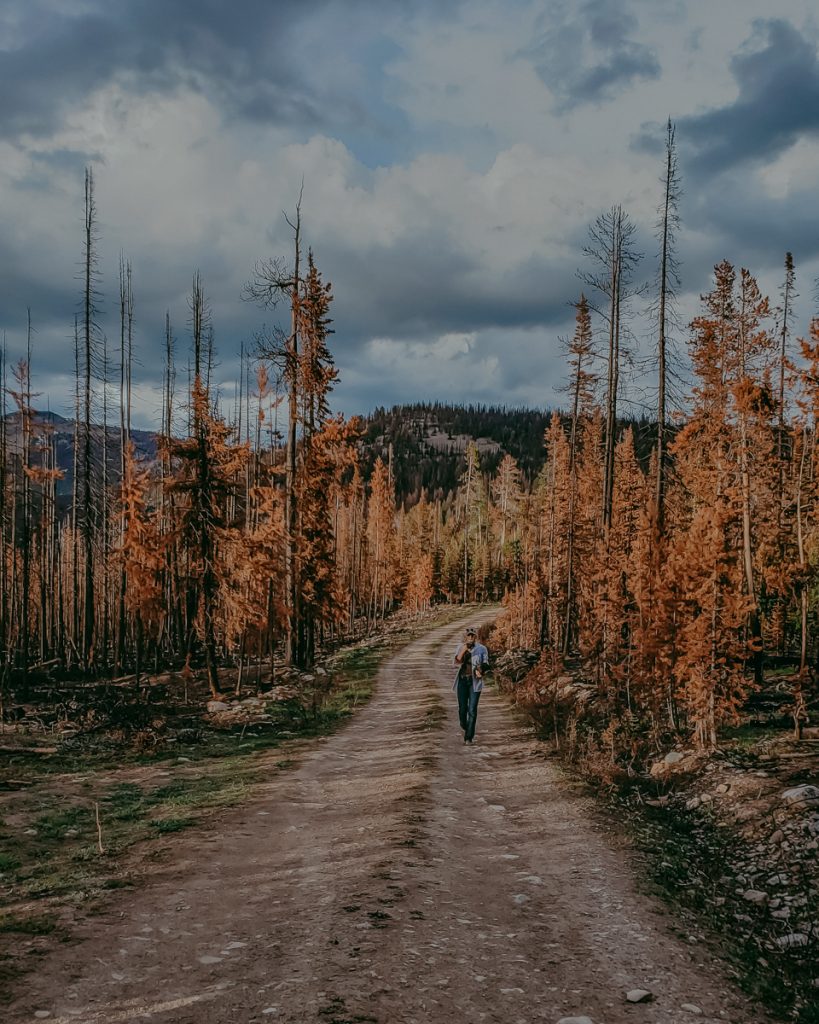
Winter transformed the ranch this week. We had a little prelude last week, I think, as a warning; 3 inches dusted everything. But this week laid snow down over the entirety of headquarters, accompanied by winter-like cold. It never went above freezing on Wednesday. I looked over at our summer grazing range in Hat Creek; it was covered with nearly a foot of new snow. I was grateful we pulled cattle out 3 weeks ago.
We were going to go “logging” today. It’s a sort of ritual for us; each year, we go and harvest firewood from high elevation lodgepole pine forests in the mountains around the Pahsimeroi Valley. We’ll find where the forest had burned, and what is left now is a skeleton forest of dense and dead timber. In this case, it’s the Rabbit Foot Fire.
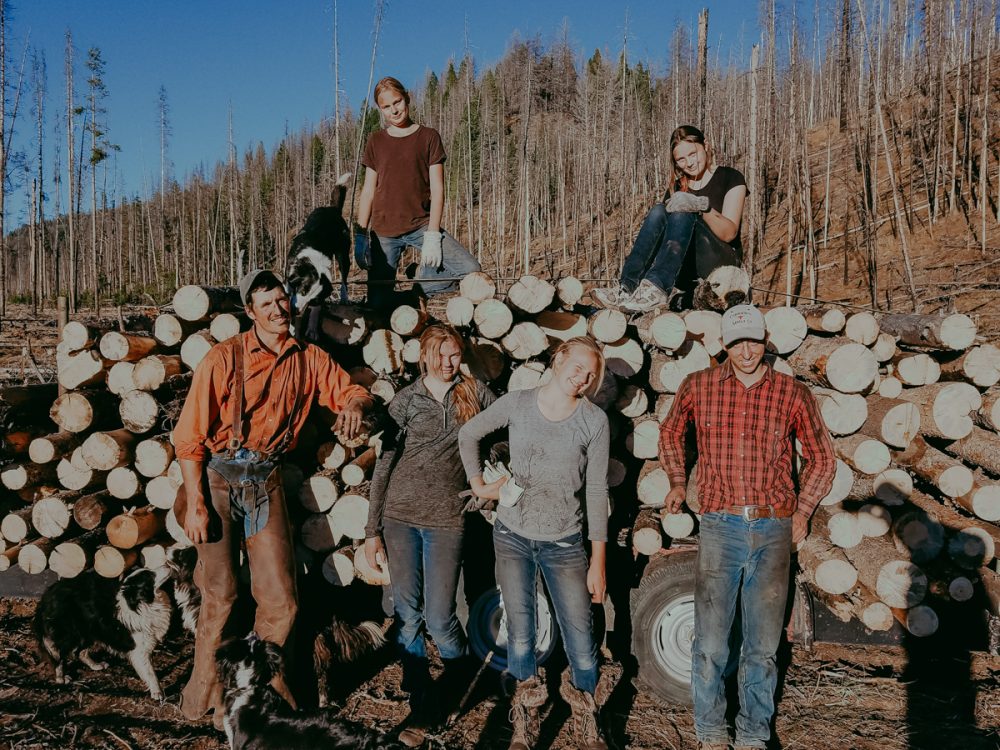
It’s another gift. It makes for easy pickings for fuelwood, and reduces the fire hazard in the near future, as all of these trees will eventually—within 10-20 years or so–fall down in what we call a “jackstraw” matrix of down trees, covering the forest floor up to 4 feet deep.
Then the forest is reprimed again for a second wildfire, this time with ground fuel. It’s akin to an undetonated bomb, just awaiting an ignition source. Lightning never strikes the same spot twice, they say, but it does strike. And the forest will burn. Not if, but when.
The cycle of fire was the norm pre-settlement in dense Rocky Mountain lodgepole pine stands. Fire was relatively frequent before well-meaning humans started putting them all out, led by that bear named Smokey. Now we’re going to have to figure out how to recreate forest health when our well-meaning predecessors let fuel loading become overwhelming. More on this another day.
But no logging today. There’s probably 2 feet of the white stuff in our intended firewood site. We’ll have to reschedule for next week if the weather warms up. And maybe, instead, we’ll have to wait until next spring. “But wait!” you might be thinking. “Why would you want to harvest firewood in the spring?”
And the answer, my friend, is that we don’t and we won’t.
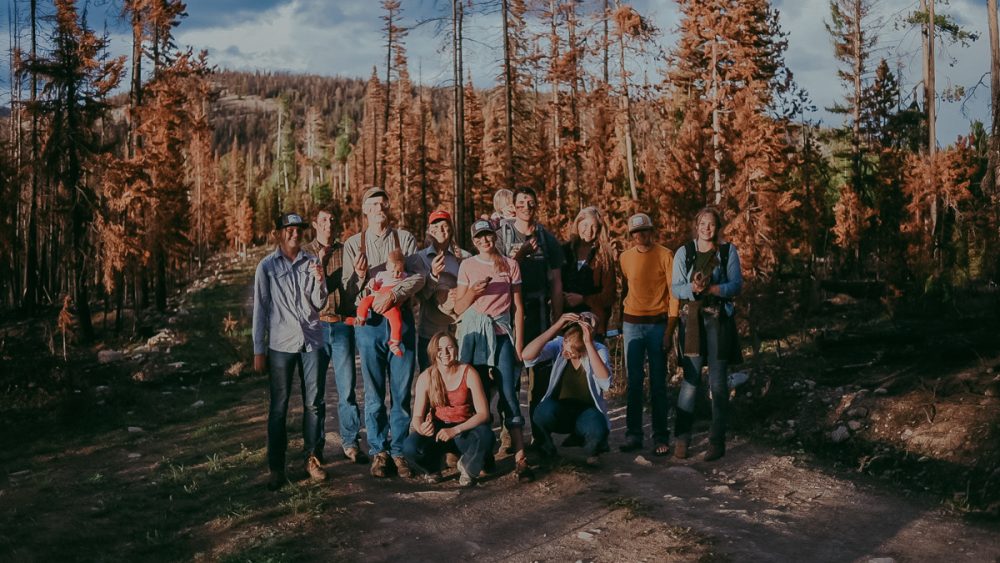
Instead, we’ll harvest morels for our table.
And so the land will give, as it always has when we care for it. It’s a faithful partner.
Happy trails.
Glenn, Caryl, Girls and Cowhands at Alderspring

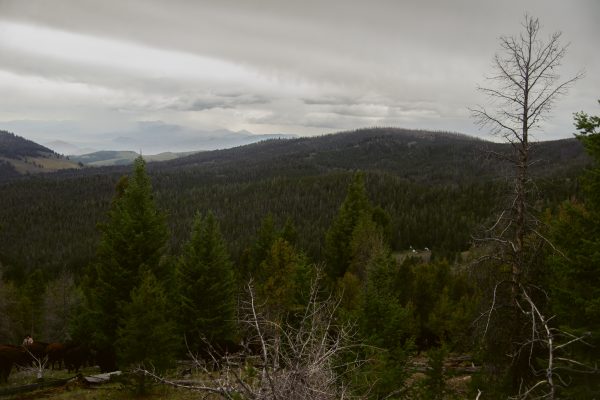

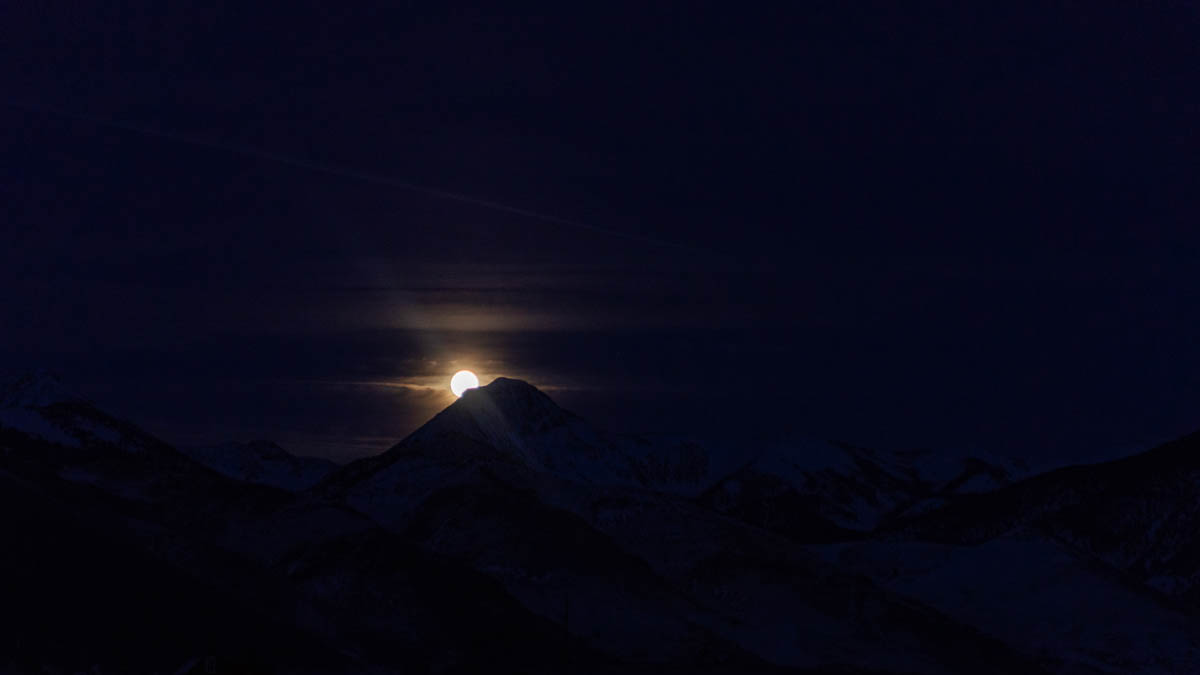
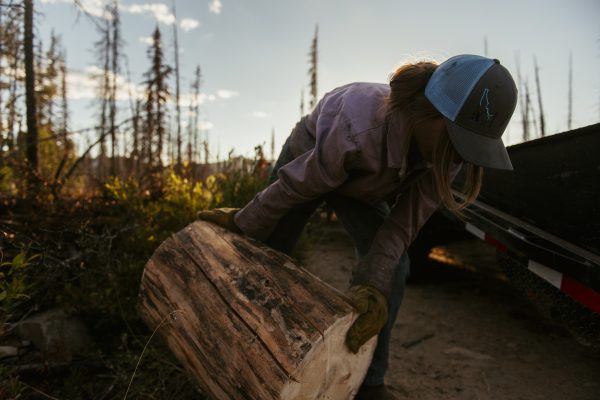


Kenneth R Fechtler
I want to be there! I would like to have a bag of spores to sprinkle on my own wood lot. Its been a long time since I ate my fill of morel mushrooms cooked in iron on a camp fire. Thank you
Tom Irvine
The morels in the pictures look really different from the morchella esculenta that I have found in the North Cascades – or even in NY State. They almost look more like Verpa Bohemia with chunkier caps (but not quite).
Does Caryl’s expertise extend to the fungal world?
Caryl Elzinga
I’ll ask her, Tom! I don’t think so…those fungi are really quite enigmatic. Anyone who says they understands them has likely been eating the wrong kinds! Hope you are well! Went through Twisp the other day and thought of you! -Glenn
Judith Burrell
What a blessing from the dear Lord that I found your wonderful web- site.
I get tears(of Joy) in my eyes everytime I read one of Glenn’s very informative “stories”. He is a walking encyclepedia!!!
I love hearing about and seeing what you are doing to maintain all of what God intended for us to do in the raising and caring of livestock.
Thankyou so much for being such a blessing to me and to all who have FOUND YOU on the internet
I just ordered for the first time and I am excited to be partnering with you as a customer. May I claim you as FAMILY?
May the Lord continue to bless you in all that you are doing to honor HIM.
Judith
Caryl Elzinga
Thanks for reading and following along Judith. We appreciate your business!
We consider you – our customers – our partners. Thank you so much.